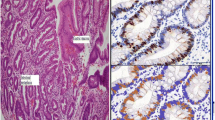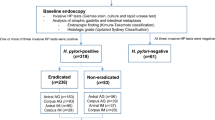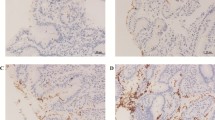Summary
Background
In several studies, different risk factors other than antibiotic resistance have been documented with Helicobacter pylori eradication failure. We aimed in this study to investigate the relationship of gastric density of H. pylori, the occurrence/degree of gastric atrophy, and intestinal metaplasia (IM) with success rate of H. pylori eradication.
Methods
Two hundred consecutive treatment naive patients who received bismuth containing standart quadruple treatment due to H. pylori infection documented by histopathological examination of two antral or two corpal biopsies entered this retrospective study. The updated Sydney system was used to grade the activity of gastritis, density of H. pylori colonization, atrophy, and IM. Stages III and IV of operative link for gastritis assessment (OLGA) or the operative link on gastric intestinal metaplasia assessment (OLGIM) stages was considered as severe gastritis. H. pylori eradication was determined via stool H. pylori antigen test performed 4 weeks after the end of therapy.
Results
The presence of gastric atrophy and IM was significantly higher in patients with eradication failure (p = 0.001 and 0.01, respectively). Severe gastritis (OLGA III–IV and OLGIM III–IV) rates were higher in eradication failure group. A multiple linear regression analysis showed that OLGA and OLGIM stages were to be independent risk factors for eradication failure (p = 0.03 and 0.01, respectively).
Conclusion
Our results suggested that histopathologically severe gastritis may cause H. pylori eradication failure. In addition, we found that H. pylori density was not a risk factor for treatment failure in patients who receive quadruple treatment.


Similar content being viewed by others
References
Go MF. Review article: natural history and epidemiology of Helicobacter pylori infection. Aliment Pharmacol Ther. 2002;16:3–15.
Brown LM. Helicobacter pylori epidemiology and routes of transmission. Epidemiol Rev. 2000;22:283–97.
Frenck RW Jr, Clemens J. Helicobacter in the developing world. Microbes Infect. 2003;5:705–13.
IARC Working Group on the Evaluation of Carcinogenic Risks to Humans. Schistosomes, liver flukes and Helicobacter pylori. IARC Monogr Eval Carcinog Risks Hum. 1994;61:1–241.
Uemura N, Okamoto S, Yamamoto S, Matsumura N, Yamaguchi S, Yamakido M, Taniyama K, Sasaki N, Schlemper RJ. Helicobacter pylori infection and the development of gastric cancer. N Engl J Med. 2001;345:784–9.
Sipponen P. Update on the pathologic approach to the diagnosis of gastritis, gastric atrophy, and Helicobacter pylori and its sequelae. J Clin Gastroenterol. 2001;32:196–202.
Malfertheiner P, Megraud F, O’Morain CA, Atherton J, Axon AT, Bazzoli F, Gensini GF, Gisbert JP, Graham DY, Rokkas T, El-Omar EM, Kuipers EJ, European Helicobacter Study Group. Management of Helicobacter pylori infection the Maastricht IV/Florence Consensus Report. Gut. 2012;61(5):646–64.
Graham DY, Fischbach L. Helicobacter pylori treatment in the era of increasing antibiotic resistance. Gut. 2000;62:1143–53.
Vakil N, Megraud F. Eradication therapy for Helicobacter pylori. Gastroenterology. 2007;133:985–1001.
Padol S, Yuan Y, Thabane M, Padol IT, Hunt RH. The effect of CYP2C19 polymorphisms on H. pylori eradication rate in dual and triple first-line PPI therapies: a meta-analysis. Am J Gastroenterol. 2006;101:1467–75.
Furuta T, Sugimoto M, Shirai N. Effect of MDR1 C3435T polymorphism on cure rates of Helicobacter pylori infection by triple therapy with lansoprazole, amoxicillin and clarithromycin in relation to CYP 2C19 genotypes and 23S rRNA genotypes of H. pylori. Aliment Pharmacol Ther. 2007;26:693–703.
Abdullahi M, Annibale B, Capoccia D, Tari R, Lahner E, Osborn J, et al. The eradication of Helicobacter pylori is affected by body mass index (BMI). Obes Surg. 2008;18:1450–4.
Suzuki T, Matsuo K, Ito H, Sawaki A, Hirose K, Wakai K, et al. Smoking increases the treatment failure for Helicobacter pylori eradication. Am J Med. 2006;119:217–24.
Sheu BS, Yang HB, Su IJ, Shiesh SC, Chi CH, Lin XZ. Bacterial density of Helicobacter pylori predicts the success of triple therapy in bleeding duodenal ulcer. Gastrointest Endosc. 1996;44:683–8.
Moshkowitz M, Konikoff FM, Peled Y. High Helicobacter pylori numbers are associated with low eradication rate after triple therapy. Gut. 1995;36:845–7.
Dixon MF, Genta RM, Yardley JH, Correa P. Classification and grading of gastritis. The updated Sydney System. International Workshop on the Histopathology of Gastritis, Houston 1994. Am J Surg Pathol. 1996;20(10):1161–81.
Rugge M, Pennelli G, Pilozzi E, Fassan M, Ingravallo G, Russo VM, et al. Gastritis: the histology report. Dig Liver Dis. 2011;43:S373–84.
Perri F, Clemente R, Festa V. Relationship between the results of pre-treatment urea breath test and efficacy of eradication of Helicobacter pylori infection. Ital J Gastroenterol Hepatol. 1998;30:146–50.
Onal IK, Gokcan H, Benzer E, Bilir G, Oztas E. What is the impact of Helicobacter pylori density on the success of eradication therapy: a clinico-histopathological study. Clin Res Hepatol Gastroenterol. 2013;37:642–6.
Fiocca R, Villani L, Luinetti O, Gianatti A, Perego M, Alvisi C, et al. Helicobacter colonization and histopathological profile of chronic gastritis in patients with or without dyspepsia, mucosal erosion and peptic ulcer: a morphological approach to the study of ulcerogenesis in man. Virchows Arch A Pathol Anat Histopathol. 1992;420:489–98.
Yamamura F, Yoshikawa N, Akita Y, Mitamura K, Miyasaka N. Relationship between Helicobacter pylori infection and histologic features of gastritis in biopsy specimens in gastroduodenal diseases, including evaluation of diagnosis by polymerase chain reaction assay. J Gastroenterol. 1999;34:461–66.
Stolte M, Stadelmann O, Bethke B, Burkard G. Relationships between the degree of Helicobacter pylori colonisation and the degree and activity of gastritis, surface epithelial degeneration and mucus secretion. Z Gastroenterol. 1995;33:89–93.
Wagner S, Varrentrapp M, Haruma K, Lange P, Müller MJ, Schorn T, et al. The role of omeprazole (40 mg) in the treatment of gastric Helicobacter pylori infection. Z Gastroenterol. 1991;29:595–8.
Lai YC, Wang TH, Huang SH, Yang SS, Wu CH, Chen TK, et al. Density of Helicobacter pylori may affect the efficacy of eradication therapy and ulcer healing in patients with active duodenal ulcers. World J Gastroenterol. 2003;9:1537–40.
Güliter S, Keleş H, Ozkurt ZN, Cengiz DU, Kolukisa E. Can lansoprazole, amoxicillin, and clarithromycin combination still be used as a first-line therapy for eradication of Helicobacter pylori? Turk J Gastroenterol. 2005;16(1):29–33.
Gumurdulu Y, Serin E, Ozer B, Kayaselcuk F, Ozsahin K, Cosar AM, Gursoy M, Gur G, Yilmaz U, Boyacioglu S. Low eradication rate of Helicobacter pylori with triple 7–14 days and quadriple therapy in Turkey. World J Gastroenterol. 2004;10(5):668–71.
Nadir I, Yonem O, Ozin Y, Kilic ZM, Sezgin O. Comparison of two different treatment protocols in Helicobacter pylori eradication. South Med J. 2011;104(2):102–5.
Bago P, Vcev A, Tomic M, Rozankovic M, Marusić M, Bago J. High eradication rate of H. pylori with moxifloxacin-based treatment: a randomized controlled trial. Wien Klin Wochenschr. 2007;119(11–12):372–8.
Bago J, Galović A, Belosić Halle Z, Bilić A, Bevanda M, Bago P. Comparison of the efficacy of 250 mg and 500 mg clarithromycin used with lansoprazole and amoxicillin in eradication regimens for Helicobacter pylori infection. Wien Klin Wochenschr. 2004;116(14):495–9.
Vaira D, Zullo A, Vakil N, Gatta L, Ricci C, Perna F, et al. Sequential therapy versus standard triple-drug therapy for Helicobacter pylori eradication. A randomized trial. Ann Intern Med. 2007;146:556–63.
Kashimura H, Suzuki K, Hassan M, Ikezawa K, Sawahata T, Watanabe T, Nakahara A, Mutoh H, Tanaka N. Polaprezinc, a mucosal protective agent, in combination with lansoprazole, amoxycillin and clarithromycin increases the cure rate of Helicobacter pylori infection. Aliment Pharmacol Ther. 1999;13:483–7.
Suerbaum S, Michetti P. Helicobacter pylori infection. N Engl J Med. 2002;347:1175–86.
Onal IK, Sokmensuer C, Onal ED, Ersoy O, Yeniova O, Aydinli M, et al. Clinical and pathological features of nodular gastritis in adults. Turk J Med Sci. 2009;39:719–23.
Mégraud F. H. pylori antibiotic resistance: prevalence, importance, and advances in testing. Gut. 2004;53:1374–84.
de Vries AC, van Grieken NC, Looman CW, Casparie MK, de Vries E, Meijer GA, Kuipers EJ. Gastric cancer risk in patients with premalignant gastric lesions: a nationwide cohort study in the Netherlands. Gastroenterology. 2008;134(4):945–52.
Rugge M, Capelle LG, Cappellesso R, Nitti D, Kuipers EJ. Precancerous lesions in the stomach: from biology to clinical patient management. Best Pract Res Clin Gastroenterol. 2013;27(2):205–23.
Pimanov SI, Makarenko EV, Voropaeva AV, Matveenko ME, Voropaev EV. Helicobacter pylori eradication improves gastric histology and decreases serum gastrin, pepsinogen I and pepsinogen II levels in patients with duodenal ulcer. J Gastroenterol Hepatol. 2008;23(11):1666–71.
Oda Y, Miwa J, Kaise M, Matsubara Y, Hatahara T, Ohta Y. Five-year follow-up study of histological and endoscopic alterations in the gastric mucosa after Helicobacter pylori eradication. Dig Endosc. 2004;16:213–8.
Kamada T, Haruma K, Komoto K, Mihara M, Chen X, Yoshihara M, et al. Effect of smoking and histological gastritis severity on the rate of H. pylori eradication with omeprazole, amoxicillin, and clarithromycin. Helicobacter. 1999;4(3):204–10.
Author information
Authors and Affiliations
Corresponding author
Rights and permissions
About this article
Cite this article
Kalkan, I.H., Sapmaz, F., Güliter, S. et al. Severe gastritis decreases success rate of Helicobacter pylori eradication. Wien Klin Wochenschr 128, 329–334 (2016). https://doi.org/10.1007/s00508-015-0896-2
Received:
Accepted:
Published:
Issue Date:
DOI: https://doi.org/10.1007/s00508-015-0896-2




